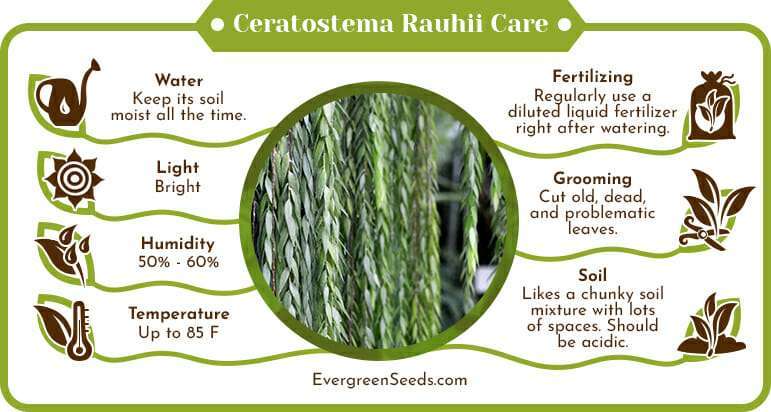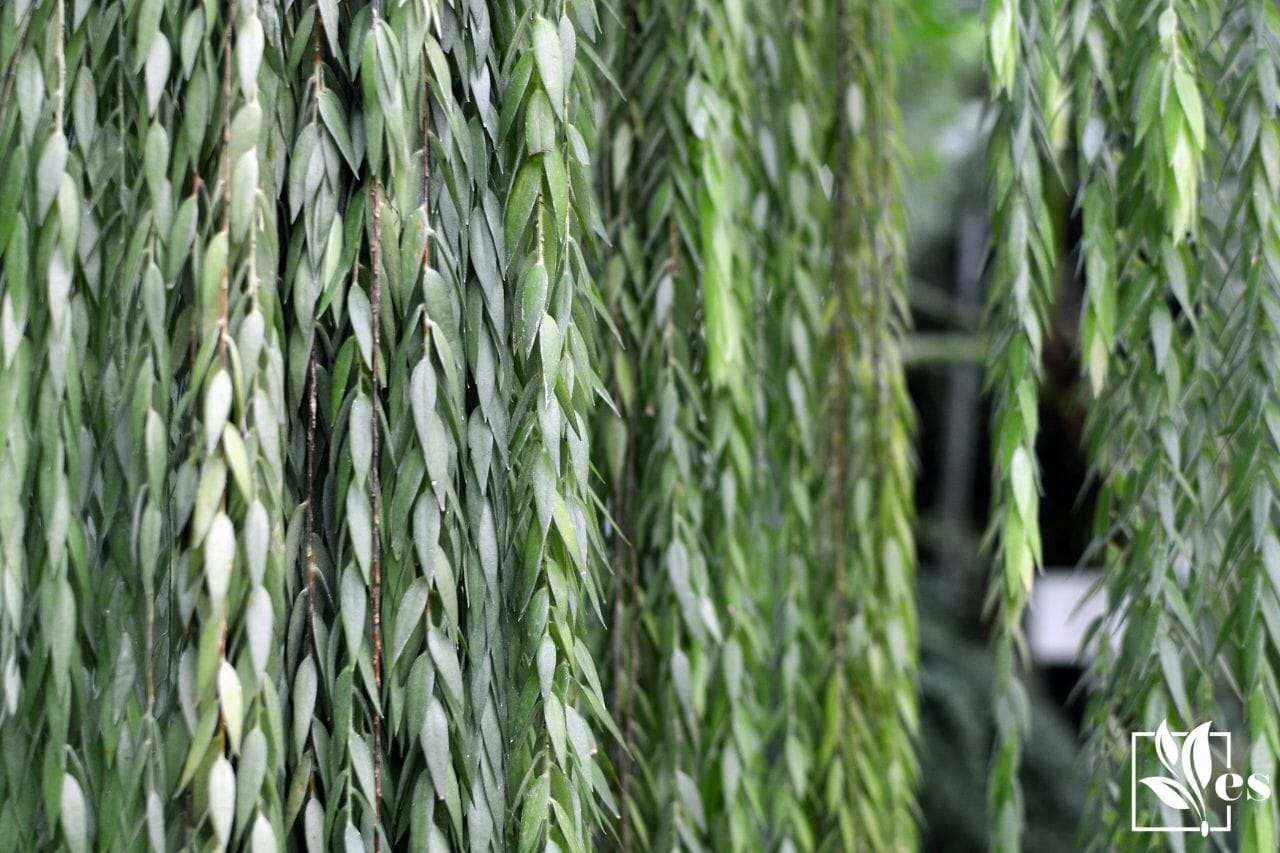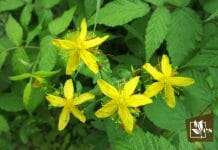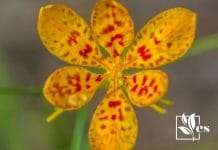 Ceratostema rauhii of the Ericaceae family is the perfect hanging plant to grow in baskets inside or outside your home. With its long, bushy stems and hanging flowers, you won’t need anything else to lift the whole look of the room.
Ceratostema rauhii of the Ericaceae family is the perfect hanging plant to grow in baskets inside or outside your home. With its long, bushy stems and hanging flowers, you won’t need anything else to lift the whole look of the room.
Plus, they are so easy to look after and propagate. We bring you this guide so you can give this rare plant of the Ceratostema genus the true care that it deserves.
JUMP TO TOPIC
What Is Ceratostema Rauhii?
Ceratostema rauhii is an endangered plant natively found in Peru. It belongs to the blueberry family and has a hanging growth habit. Its stems grow up to 6 feet tall along with fuzzy leaves. Just like ceratostema villosa, it produces bell-shaped and bright red flowers that hang upside down.
Ceratostema Rauhii Care
The care guide for this plant includes shaded sunny locations, high humidity levels, and moderately cool temperatures, especially during the nighttime. Use a diluted liquid fertilizer regularly and don’t forget to groom your plant every spring.
You can read more about the care needs ahead.
 Water Requirements
Water Requirements
Now this is a plant that loves being watered. You should keep its soil moist all the time. It shouldn’t be allowed to dry at all, even from the top. That is why keeping a moisture meter might be your most useful investment — as soon as you feel the soil moisture level going down, water right away.
During the spring and summer months, you will need to water this plant almost every other day. This is because the soil dries up faster during these months. Use ample quantities of water for this epiphyte and pour the water slowly until it begins to drain out.
– What Water To Use
Municipal tap water can be used to water this plant, but if this water contains high levels of salts and minerals, then you will notice yellowing, drooping, and discoloration of leaves happening.
In such a case, replace tap water with distilled water. You can also store rainwater and use it to water this plant. Filtering tap water is another viable option.
 Light Requirements
Light Requirements
 Your rauhii houseplant doesn’t really need direct sun to grow and be happy, it just needs loads of bright light.
Your rauhii houseplant doesn’t really need direct sun to grow and be happy, it just needs loads of bright light.
It is best to keep this plant somewhere shaded but lit brilliantly. Filtered light from a curtain is safe and adequate too.
While it can tolerate direct sunlight in the morning and evening, keep away from mid-afternoon sunshine. This is when the sun is at its harshest and your plant can get seriously sunburnt.
When keeping them inside the house, the northern-facing window in the room is not adequate enough. Low light will cause the leaves to become lighter and start to droop. You will have to use substitute artificial lights and install them over the plant.
 Soil Requirements
Soil Requirements
Rauhii ceratostema, like other similar plants ceratostema pendens and ceratostema glans, likes a chunky soil mixture with lots of spaces. The soil also needs to have the dual ability to retain moisture and drain all excess water. When it comes to the pH, the soil should be acidic.
Learn how to make the best soil below:
- Start with a typical store-bought orchid or epiphyte mix. This comes prepackaged with all the nutrients your plant needs to kickstart its life.
- Add medium-sized chunks of bark, perlite, or coco coir to the mix in equal parts. These substances create spaces within the soil.
- The next most important ingredient is to add peat or sphagnum moss. They absorb moisture during watering and then slowly release it over time. They are most important for moisture retention.
- Avoid adding lime or any alkaline substances to your soil. This plant grows poorly in such soil.
 Temperature Requirements
Temperature Requirements
Rauhii ceratostema is a cool growing epiphyte. It needs daytime temperatures to be up to 85 degrees Fahrenheit and nighttime temperatures up to 65 degrees Fahrenheit.
In fact, this drop in temperature from day to night is quite essential for its growth. It also serves as the stimulus for the flowers to bloom. Keep the windows a notch open at night.
Even so, this isn’t a frost-hardy plant and will experience transplant shock under very cold conditions. It might stop growing or begin to die altogether. It is always best to move your rauhii indoors during winter.
 Humidity Requirements
Humidity Requirements
A range between 50 to 60 percent humidity is most apt for your rauhii epiphytes plants. This one needs high air moisture levels or its overall health is negatively impacted.
Here are some ways you can ensure humidity remains within the proper range around this beauty.
- A DIY humidity tray is the easiest method. You will need a shallow tray along with some pebbles and water to fill it with. This tray is to be put under the potted plant such that the pot doesn’t directly touch the water.
- A humidifier is quite expensive to buy and run all the time. However, it does maintain the required levels of humidity very accurately all day round.
- Misting is the practice of spraying the plant’s leaves lightly. This is best done in the early or late morning. Misting late into the day can cause fungal infections to develop on the leaves.
 Fertilizing Requirements
Fertilizing Requirements
The recommended practice is to feed your plant regularly but not more than once a week. Use a diluted liquid fertilizer right after watering. This simple trick will save you the hassle of dealing with fertilizer burns. You can cut back on fertilizing during fall and winter to once per month.
 Pruning
Pruning
Groom your rauhii plant by pruning off crooked and off-kilter stem ends. Look out for leaves that are old, dead, or problematic and cut them off. Deadhead all the flowers at the end of the blooming season.
Propagation
You will rarely find Ceratostema for sale. This is because it is a very rare plant to find and is, in fact, considered an endangered species in its native country Peru. That is why it is very important for you to learn how to propagate it at home.
There are two methods to do this. Let us discuss both of them here.
– Stem Cuttings
This method is the more popular of the two because of how easy it is.
- For starters, clean the gardening tools that you will be using. Use a knife in order to obtain a stem cutting that is one to two inches long.
- Let the cutting dry out before applying rooting hormone to the end that was cut.
- Make a brand new potting mix and plant the stem cutting in it. The side which was cut should go into the soil.
- Without letting it become muddy, keep the soil moist all the time. Also, make sure it gets bright light and abundant moisture in the air.
- It will take only two to three weeks before you start seeing new growth in the pot.
– Seeds
Seed propagation needs a lot of time and patience. If you feel up to the task, then carry on reading to learn its steps.
- Buy a seedless nutritional growth media and spread it evenly on a tray. Pour some water on it to make it wet.
- Insert your seeds in this mix one by one, taking care not to damage them.
- Lastly, cover the tray with a transparent wrap and put it somewhere warm and brilliant.
- In a few weeks, some of the seeds will germinate. Wait some more until the seedlings are large enough. Afterwards, transplant them to their new pots with properly mixed soil.
Problems
The two most common problems you might expect with the rauhii plant are leaf tip dying and pest attacks. Learn all about these problems along with how to tackle them here.
– Leaf Tip Die Back
This is a condition in which the leaves of the plant begin to die from the tips. The cause behind this condition is either over-fertilizing or a build-up of salts in the soil after regular use of fertilizer or hard water.
In order to solve this problem, remove the cause first. If you are overfertilizing, then cut it back to no more than once per week. Always dilute the fertilizer first.
It is also imperative to use abundant water to flush out the salts from the soil at least once a month. Also, have your water checked for hardness. We would suggest using distilled, filtered, or rainwater instead.
– Pests
Mealybugs are the most commonly-occurring bugs in this plant. They secrete goo-like stuff on the surface of the leaves that attracts mold. They also cause the foliage to turn yellow and curl around the edges.
You need to get rid of mealybugs by washing the plant and using a strong insecticide.












